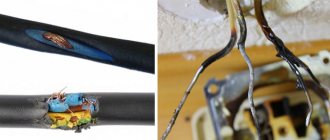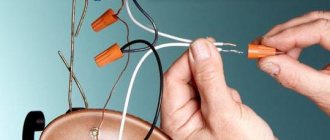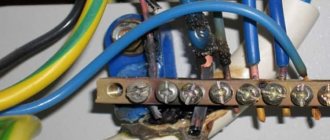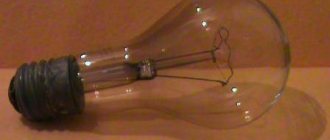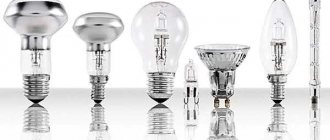How does a light bulb work?
First of all, you need to understand how light bulbs function. You can consider their operating principle using the example of an incandescent lamp. The current passes through a thin spiral made of tungsten. The melting point of this metal is quite high. Tungsten filament can heat up to 2500°. When the coil gets hot, it emits light.
Inside the flask is filled with gas, such as argon or a mixture of gases. Under its pressure, the rate of destruction of the tungsten filament decreases. But still, over time, it breaks down into small particles. Then weak spots appear on the conductor where it can break.
In gas-discharge lamps, the gas inside the bulb glows. The glow occurs under the influence of an electric charge.
Manufacturer defect is the most common reason.
The cheapness of lamps (especially LEDs) is, of course, good, but purchasing lamps at a low price is not the best solution. What can be a manufacturing defect in the manufacture of a lamp? Poorly cast lamp bulb. The unevenness of the glass structure, especially near the lamp base, leads to the appearance of cracks and possible depressurization of the bulb due to a constant change in the thermal regime (heating when turned on, cooling when turned off); Uneven application (or incomplete filling of the lamp base) of the adhesive composition that “holds” the lamp bulb and base together, as well as the quality of this composition, which is also subject to temperature changes during operation; Poor quality lamp driver components. This is the circuit that is assembled in the housing of an energy-saving or LED lamp. Often, cheap lamps of this type have an insufficient resource of circuit elements, as well as a small area of heat dissipation from the driver. The indirect criterion is the weight of the lamp; "Overclocked" lamps. This, of course, applies more to LED lamps. To save money, the manufacturer can make changes to the driver circuit so that the LEDs are powered by increased current or voltage. At first, such a lamp will shine very brightly, but it can also quickly fail, and the LEDs can “degrade”; The listed types of defects cannot be detected without starting operation or without disassembling the lamp. Of course, if you see air bubbles or, especially, small scratches and cracks in the material of the transparent flask, you should refuse the purchase. But the most obvious defect is: Deformed lamp base. This type of defect is rare, but can be easily checked right in the store. It is enough to unpack each of the purchased lamps. If you see that the base is bent, refuse to purchase. However, even if you have not tested the lamp in a store, you have two weeks to return the product without traces of installation; The conclusion is obvious. Even if the operating conditions are met, the buyer is not insured against hidden defects in products purchased at a low price or at points of sale of uncertified products.
How lamps explode
As you know, all household appliances are powered by a 220 V AC network, which is constantly changing. When the light source coil cools, its resistance decreases by 10 times. The maximum permissible voltage for a regular light bulb is 240 V.
If, when it was turned on, the coil was cold and the voltage was maximum, then the lamp would quickly burn out or explode. For the same reason, air can get inside the flask, which is heated by the spiral, and then the bulbs burst.
During operation, the lamp body is sealed, the bulb cavity is evacuated or filled with gas. During an explosion, the pressure on the inside and outside of the body stabilizes, so a pop occurs.
How to solve a problem
Constant crackling, flickering light, and an explosion when turned on are clear signs of a faulty cartridge.
First, you should find out the possible cause of the light bulb explosion, and only then choose a way to solve the problem:
- Unscrew the burnt out light bulb and wipe the contacts in the socket with industrial alcohol.
- Check that the mains voltage matches the operating range of the light bulb.
- Disassemble the chandelier, unscrew and dry the socket.
- Buy better quality light bulbs.
- Connect the chandelier through a voltage stabilizer.
If none of the methods help, then the problem is in the chandelier itself. In this case, you will have to completely replace the device.
Why do light bulbs explode when turned on?
If you don’t know why the light bulbs in the chandelier explode when turned on, then try to figure out the problem yourself. The most common reason is the use of a light source of dubious quality. But, if the situation repeats itself, and you have tried devices from different manufacturers, you will have to figure it out.
A possible explosion can be caused by power surges, problems with wiring, design of lampshades, mismatch between the power of the lamp and the lighting fixture, etc. There can be many reasons for damage to the light source, so they should be considered in more detail.
Ventilation of the ceiling
If you are using a regular light bulb and the lamp has closed shades, then be prepared for it to explode. This is due to the fact that the light source heats up during operation. If the lamp shade of a lighting device is partially or completely closed, then the heat simply cannot escape outside. Then the lamp will overheat.
Due to constant temperature changes, the adhesive base of the base is destroyed, and it gradually separates from the light bulb. When air enters the bulb when the lamp is turned on, it explodes.
To improve the ventilation of the lampshade, you can drill holes in it (if the body is metal). Then the air will circulate freely, and the light source will not overheat as much.
To restore air exchange in a glass lampshade, in the area where it is attached with a washer, place 3 pieces of dense material (non-flammable). Then the air will come out and the lamp will not explode.
Mains voltage
A common cause of damage to the integrity of a light bulb is power surges. For more modern electrical appliances, stabilizers are connected to maintain a constant load current in the network. Then the equipment works longer and without problems.
LEDs
High-quality LED products definitely do not explode. But cheap products from Chinese brands come from time to time. By definition, LEDs cannot explode, but an LED lamp is equipped with a power supply with a rectifier, which includes a filtering electrolytic capacitor, so it can explode. What is the reason?
To save money, the Chinese install elements designed for low voltage, for example, 63 Volts instead of 400. Under normal conditions, they still function somehow, but at the slightest deviation from the rated voltage upwards, they explode. As a result, the lamp housing may also rupture (although this rarely happens).
So we looked at the main reasons why light bulbs in a chandelier and other lamps explode. As you can see, lamp explosions mainly occur due to problems with the voltage in the network, poor quality assembly, or improper operation. We hope that the article provided was useful and interesting for you!
Many people have encountered a problem when, when turning on the light in a room, an incandescent lamp suddenly explodes with a bang. Naturally, this is unpleasant - there is fear, and darkness in the apartment, and even the base from a burst lighting fixture must somehow be removed from the socket. But removing the part remaining in the lamp is only half the battle. It is necessary to understand why light bulbs in a chandelier explode when turned on and how to avoid such incidents in the future.
In fact, lamps burst for several reasons. It is necessary to understand what they are and what measures it makes sense to take so that this does not happen again.
Of course, the main and most common cause of such pops is the low quality of the product, i.e. incandescent lamps. But this is the simplest reason, which can be eliminated by replacing the lamp, and therefore you should not dwell on it seriously. But if the lamps have been changed more than once to devices from different manufacturers, but the problem remains, you should dig deeper.
Useful tips for those whose lamps explode
If a lamp exploding in your apartment is not uncommon for you, then follow the following expert advice:
- Replace conventional light bulbs with halogen or LED light sources with a power supply. Their price is a little higher, but they last much longer.
- If you have old wiring and switches, try to replace them as soon as possible.
- Buy light sources from trusted manufacturers, such as Philips. They use only high-quality parts when making lamps. When choosing a lighting element, pay attention to its appearance, and also study the characteristics.
- Select light bulbs and fixtures of the same power.
- Do not connect conductors by twisting, use terminal connections.
If after the lamp explosion the base remains in the lamp, then de-energize the room and unscrew it with needle-nose pliers with insulated handles.
How to get rid of negativity
Periodically, every home requires cleaning for the following reasons:
- too much human energy accumulates;
- negative thoughts of family members;
- frequent quarrels;
- the negativity accumulated over the years does not allow you to advance in your career or studies;
- the family’s financial situation suffers;
- Frequent illnesses due to problems with electricity may indicate a magical influence on your family.
Loneliness and an urgent need for communication, melancholy can affect the general atmosphere of the house, which is why light bulbs can often burn out. To stop suffering from loneliness, you can get yourself a pet.
Lamp life
Most often, lamps with tungsten filament, fluorescent, halogen and LED light sources are used in residential premises. The duration of their work depends on the technology used:
- Conventional lamps last up to 1000 hours. However, after 750 hours of burning, the light becomes dimmer.
- LED lamps can operate for about 50,000 hours (up to 15 years). However, in reality, their service life is reduced to 5 years, but this is also a better result compared to other types of lamps.
- Fluorescent light sources can operate for 20,000 hours. However, this is only possible if the following conditions are met: infrequent switching on, no voltage drops.
- Halogen devices are equipped with a filament that is protected from rapid destruction by a buffer gas. Therefore, their rated life is greater than that of conventional light bulbs - about 4000 hours.
To extend the life of the light bulbs, it is recommended to use a power supply.
Poor quality products
Unfortunately, the main reason for LED burnout is poor build quality. In our search for cheap LED products, we often fall for the trick of Chinese brands - bright light bulbs that, as advertising, shine quite well on the stand and at the same time have a stylish design. The fact is that most LED products from China are manufactured in such a budget version that the light bulbs burn out due to the lack of elements for protecting the LEDs from surge current in the driver circuit. As a result, during voltage surges, the current increases, due to which the LEDs heat up above the nominal temperature and, of course, burn out.
In addition, let’s return to one more reason, which is closely related to the advertising move when demonstrating the glow of a light bulb on a stand. When choosing an LED lamp for the home, we all try to find an option that will shine well and at the same time be cheap. That is why some manufacturers select resistors and capacitors in light bulbs in such a way that the LEDs work at full power, but brightly. As a result, the service life of the products is quickly reduced and they burn out.
Also, another reason for the frequent combustion of LED lamps is a defect in the configuration and a violation of the soldering technology, which is typical for cheap Chinese products.
You can verify the above by watching these videos:
Can weather affect lamp failure?
Practical case. Residential building of Stalinist construction, high ceilings, external wiring in the apartment. The wiring to the terminal sockets and switches is laid in an open way (twisted two-core wire on insulators). Every autumn, lamps burn out with enviable consistency when turned on . The first step was to inspect the electrical system in the entire apartment from the panel to all sockets and switches for loose contacts, oxidation of stripped sections of wires, burnout at the terminals, etc. Including, voltage measurements were taken during the week. Although several problems with contacts were discovered, efforts to eliminate them did not lead to results. The voltage in the apartment was always normal, but the light bulbs continued to explode every day. On one of the cloudy autumn days, the electrician heard the crackling sound of sparks in several places in the apartment and it was obvious that the lighting in the apartment was blinking in time with the electric crackling sound. Because the wiring was open, the places where the cracks were located were identified and inspected. The reason turned out to be old fabric insulation of twisted wires, which, moreover, were repeatedly painted with different compositions (from whitewash with lime to water-based paint). The essence of the phenomenon turned out to be very simple. During the season of high humidity (autumn, rainy weather), in the absence of normal ventilation in the old house, the fabric insulation picked up moisture and in some places an incomplete short circuit occurred, which caused short overvoltages on end consumers. If a TV or other household appliance can withstand short changes, then unprotected lighting lamps directly take over everything. And this is in addition to the fact that the insulation of the twisted cable conductors was itself aged by periods of use and repeated exposure to limes and paints. This version was confirmed by using temporary pieces of new VVGnG 3x1.5 wire with the same switches. While the bulbs in the old sites continued to explode, the bulbs in the temporary sites continued to operate reliably. This case clearly has a seasonal origin. It is complicated only by its decision. It is necessary to completely remove the old external wiring on the insulators, replacing it with a new one. There are no other solutions.
The lamp broke. What to do?
The question arises, what to do if the light bulb does break, and mercury vapor is so dangerous.
First: don't panic. If there are several people in the apartment, urgently evacuate the extra people; To eliminate the consequences, one, maximum two people should remain to avoid mass poisoning. Close the doors tightly to prevent harmful impurities from leaking into other rooms, open all windows to create a draft to reduce the effect of vapors on the respiratory system. Collect the fragments in a bag and, as far as possible, seal it tightly without touching it with your bare hands.
It is better to work with rubber gloves. Wipe the dirty areas with a damp cloth and place them in the bag as well. Carpets should be taken outside and beaten, placing the inside side down, but not on the ground; To prevent soil contamination, place a damp sheet or oilcloth.
Demercurization (the process necessary to neutralize mercury) must be carried out. There are special services for this. If it is not possible to invite specialists, the room where the mercury lamp has broken will be properly cleaned using the following compounds:
- solution of potassium permanganate (2 g per 1 liter of water). Apply the resulting mixture to the contaminated area and wash it off with soapy water after 6–7 hours;
- baking soda solution (400 g of soda per 10 liters of water and a little soap suds). Chlorine-based bleaches can also be used;
- for minor stains, you can take 100 ml of iodine per liter of water and treat the surface with this composition.
How much mercury is in an energy-saving lamp?
Depending on the characteristics of the energy-saving lamp, it may contain from 1 to 400 mg of mercury. If we compare it with a thermometer, then the amount of this metal in it is much greater - 2 g. A health threat is observed if the concentration of mercury vapor in the room is from 0.25 mg/cu.
Light bulbs that are produced in our country or in China contain mercury vapor, but devices from manufacturers from European countries contain mercury almagama (an alloy with another metal). It is less dangerous to health.
Considering the fact that in fact the danger of a broken energy-saving lamp is mostly exaggerated, you should not be scared or panic. However, everyone should be clearly aware that such light bulbs must be treated very carefully. This should be clearly explained to children.
The question of what is more dangerous is also quite relevant - if the thermometer breaks, or if the integrity of the lamp is lost. Despite the abundance of safe thermometers, mercury thermometers are still used in many families. It is a broken thermometer that is more dangerous, since small balls of mercury can roll into a variety of places and remain in crevices that are inaccessible for cleaning. If left indoors, mercury will poison the air for a long time. But if the integrity of an energy-saving lamp is damaged, there is no need to look for balls on the floor, since the mercury inside is only in the form of vapor. That is why the harm of energy-saving lamps in this case is less pronounced.
Only one lamp burns out regularly.
Also, a case from practice. In a three-room apartment, only one light bulb in one lamp constantly burns out. Upon inspection, it turned out that the lamp had one lamp, tightly closed with a shade. It is located in the kitchen, not far from the ventilation duct and grille. After the lamp was removed, several drops of water were found inside it. Having unscrewed the lamp, we discovered that the socket contacts were regularly cleaned of rust during the next replacement of the burnt-out lamp. Where does the water in the lampshade come from and, accordingly, the rust on the socket contacts? No leak or traces of it were found. It turned out to be simple. A phenomenon called “ventilation draft reversal” was occurring in the apartment. When under normal conditions the direction of air flow was OUT of the apartment, at some moments the draft changed and the flow of cold air greatly cooled this lamp. As a result of such changes in the environment, moisture condensed inside the lampshade. Next is the destruction of the socket by rust and all the accompanying problems with burnouts and explosions of lamps. Without touching on the reasons for the “draft reversal” in ventilation, it was said above that if the lampshade or lamp body does not have enough holes for the heated air to escape, this may cause overheating and then an explosion of the lamp bulb. In this case, in order not to move or change the lamp, the solution to the problem was to install a check valve on the ventilation hole and remove the seal (rubber ring) between the body and the lamp shade. This case is complicated because the problem of draft overturn in new buildings is very difficult to solve. There is no specific way. A certain combination of open windows and doors anywhere on the floor (including in neighboring apartments) can change the direction of the draft. Therefore, the only solution left is to install valves for ventilation.
Errors in lamp manufacturing and their incorrect use
Production quality
The reason why household lighting bulbs explode may be hidden in them themselves. There are two options here. The first is low quality products. The modern market of electrical equipment and accessories is flooded with products of dubious manufacture. It is popularly called “Chinese”, although it can also be held in other Asian countries. Local manufacturers export lamps at a very low price and, in order to make production profitable, use low-quality raw materials for production. These may be unsuitable alloys, glass, or parts. As a rule, such a manufacturer honestly tries to make a good lamp, but is forced to save money. Because of this, minor discrepancies with technical specifications arise.
Russian manufacturers, on average, produce better products, but are still inferior in quality and functionality to world-famous Western brands. This is also related to economic considerations in production.
Technical requirements of the lamp
Reason #3 – bad contacts
Very often, the cause of an incandescent lamp explosion is poor contact. For example, if the socket connections are not tightened properly, this will again lead to heat and the lamp will explode.
It makes sense to inspect the input cabinet, and most carefully, the connection of the neutral wires, since this is the weakest point and a very common cause of various troubles. If there is poor contact between the neutral wire and the neutral block, there is a constant change in the voltage in the network, and sometimes quite sensitive.
Such jumps are especially noticeable if any powerful device is turned on on the same pair (phase-zero). Just when it is turned off, a sharp surge in voltage occurs due to the fact that with poor zeroing, the voltage in the network does not have time to stabilize. As a result, the weakest link in the chain usually fails, and this, naturally, is an unprotected incandescent lamp.
Elimination
Treating such “sores” is quite simple. To prevent the device from exploding, it is necessary to monitor the condition of the contacts, switches, and cartridges. If this is not done, the lamps will continue to burst.
To prevent this, it also makes sense to install a dimmer instead of a switch and a stabilizing device at the input.


